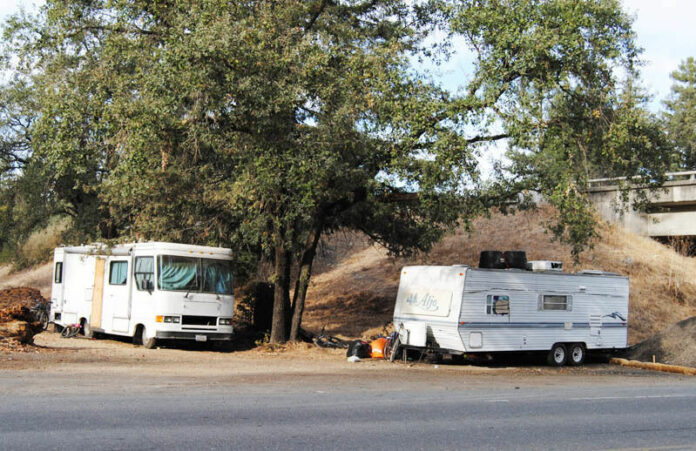
County homeless service teams recently relocated most inhabitants of an illicit homeless encampment just north of the city of Healdsburg limits, but some of the people declined shelter or services and now have relocated to the Highway 101 un
Outreach teams expanded and hotel purchases made to provide support housing
The lack of affordable housing, demands for supportive services for the county’s shelterless population, related mental health needs and rising basic needs for food, medicines and other social safety net issues continue to cost Sonoma County residents, including everyone with or without a shelter. County supervisor Shirlee Zane this week called it a “terrifying crisis.”
Just in the past two weeks, the county government and other agencies committed to spend $6.3 million for a hotel in Santa Rosa to convert to permanent support housing, approved $5.5 million for expanded mobile support teams for homeless outreach and recorded the passage of Measure O by county voters to add a quarter cent sales tax to raise $25 million annually for mental health and other social services and facilities for children, adults, veterans and seniors experiencing homelessness.
On Tuesday, the Sonoma County Board of Supervisors unanimously approved spending $5.5 million of PG&E wildfire settlement money to fund three years of mobile and crisis intervention staffing, primarily for north Sonoma County including Cloverdale and Healdsburg.
As the year 2020 was beginning, the county government spent $2 million for temporary shelters at Los Guilicos in eastern Santa Rosa, part of a larger $12 million expenditure program to relocate 258 homeless people from the Joe Rodota Trail in west Santa Rosa, purchase two properties for emergency shelters and to fund additional outreach services.
There are so many “moving targets” and homeless population needs that a total price tag on the many combined efforts and programs would be a challenge to compute. A Civil Grand Jury report released in June was critical of some of the leadership response to local homelessness and called for better accounting of expenses. The report also applauded some improvements in lowering the overall homeless population in the county over the preceding 12 months. With the official annual 2020 Point-In-Time Homeless Count still unreleased, a preliminary summary by Barbie Robinson, director of the county’s department of health services and interim executive director of the Sonoma County Community Development Commission, said the homeless population had been reduced from 2019 by 7%, decreasing from 2,951 individuals to 2,745.
Needless to say the economic impacts to local families and individuals from the coronavirus pandemic has not helped as homeless encampments keep amassing in all parts of the county, including recently north of Healdsburg, in west and southwest Santa Rosa, Sebastopol’s Morris Street and in the river area around both Guerneville and Cloverdale.
Prior to the COVID-19 related shelter-in-place orders in March 2020, a Northern Sonoma County Homelessness Planning Task Force had been meeting on a monthly basis. The meetings were attended by city officials from Cloverdale, Healdsburg and Windsor, along with county staff and staff from the north county nonprofit homeless service Reach For Home.
One of the task force’s key strategies was moved forward this week with the $5.5 million funding for expanded Mobile Support Teams (MST). Previously, only Reach For Home provided homeless outreach north of Windsor, where the official homeless count in 2019 tallied 248 homeless people.
The MST is comprised of behavioral health clinic specialists, substance abuse counselors, emergency medical technicians and outreach and intake specialists. The MST provides crisis intervention alongside law enforcement to help find appropriate solutions to mental health or other interventions. The $5.5 million will pay to add eight new staff for the next three years, through June 30, 2023.
The MST staff can write involuntary holds for psychiatric treatment if necessary, but often are able to develop plans with individuals that will allow them to remain safely in the community and access resources on a voluntary basis, according to a county staff report that was approved by unanimous vote by the county supervisors during the Nov. 10 meeting.
Plans may involve calling in friends or family members, accessing immediate resources such as shelter beds, Adult Protective Services, Child Protective Services, detox and making arrangements to meet with doctors, therapists or other treatment providers the next day. Follow-up phone calls and/or home visits by Mobile Support Team staff, as well as peer and family providers, help to ensure that people are getting connected to the treatment and services they need, the report also summarized.







